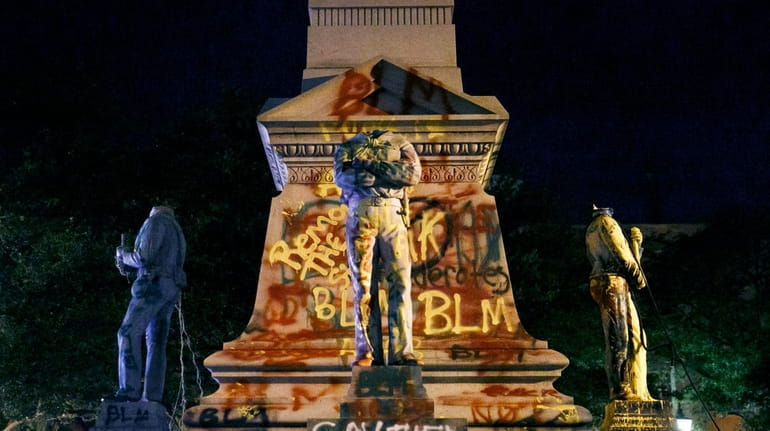What would Lincoln say about Confederate monuments?

The statues on the Confederate monument are covered in graffiti and beheaded after a protest in Portsmouth, Va., on Wednesday. Credit: AP/Kristen Zeis
The day after the South surrendered, President Abraham Lincoln asked that “Dixie” be played at the White House.
It’s tempting to think Lincoln was being magnanimous, but in truth he only knew a few tunes and “Dixie” was his favorite among them.
"I have always thought ‘Dixie’ one of the best tunes I have ever heard,” Lincoln said. “Our adversaries over the way attempted to appropriate it, but I insisted yesterday that we fairly captured it … I now request the band to favor me with its performance."
If Lincoln meant to convey additional meaning in his selection, it wouldn’t have been out of character. The day before, April 9, 1865, he had shown unexpected mercy on the defeated Confederate forces in his terms of surrender. Guns would be confiscated, naturally, but the southerners would be allowed to keep their mules and horses for the planting season ahead. Unlike the victorious allies at Versailles a half century later, Lincoln understood the importance of reconciliation. Wounds must be bound quickly, lest they reopen.
I’ve always considered Confederate statues in that light, perhaps naively. The same went for the Confederate flag. I viewed them as distant symbols of southern military pride — I still do to some extent — memorializing those lost in the great war, just as we do in the North. (I had family on both sides of the conflict. A great, great uncle, Capt. Henry Brooks O’Reilly of Rochester, New York, was killed at the Battle of Williamsburg; a great, great grandfather, George Henry Wassem, was wounded during the Red River Campaign as a member of the Louisiana Crescent Regiment.)
But the reconciliation of yesteryear had nothing to do with black Americans. The fraternal symbolism — the mutual military respect that the statues ostensibly displayed — was among white Americans. The sentiments of African Americans were neither solicited nor considered. (Statues erected in the South during the Civil Rights movement were clearly meant as a racial affront.)
The unlawful toppling of Confederate monuments during Black Lives Matter demonstrations is tearing at the old wounds; it’s scratching at an infection hastily sewn over during Reconstruction. The nation was bound back together physically, but septicity lurked beneath the stitches, especially in the South. Maybe, just maybe, we can heal them now in a lawful way.
In a striking gesture, Senate Republicans voted this week to rename the 10 federal military bases named after Confederate commanders, against the explicit wishes of President Donald Trump. The forts are household names: Bragg, Benning, Hood, Lee and Pickett among them. The Navy and Marine Corps have banned Confederate flags on its bases, and the other branches of the military are almost sure to follow. Makes sense: Confederate leaders led an insurrection against the federal government. Why is the U.S. military honoring them?
In all but Mississippi, the Southern Cross has been stripped from state flags, and states below the Mason-Dixon must now grapple with what to do with their remaining 718 Confederate monuments and statues. Should they be removed and destroyed? Have historical references attached to them? Be moved to museums? What about flags on Confederate graves? It will be up to those states to decide, and the decisions will be painful, but potentially curative in the long run.
The day after “Dixie” played at the White House, Lincoln delivered a fateful speech. “In the present ‘situation’ as the phrase goes, it may be my duty to make some new announcements to the people of the South,” he said. “I am considering, and shall not fail to act, when satisfied that action will be proper.”
Lincoln was speaking about voting rights for emancipated black men. It didn’t escape the notice of a certain audience member: “That is the last speech he will ever make,” John Wilkes Booth seethed to a friend. And indeed it was.
One wonders what Lincoln would make of the fight over Confederate symbols today. Would he be satisfied that action is now proper?
William F. B. O’Reilly is a consultant to Republicans.

